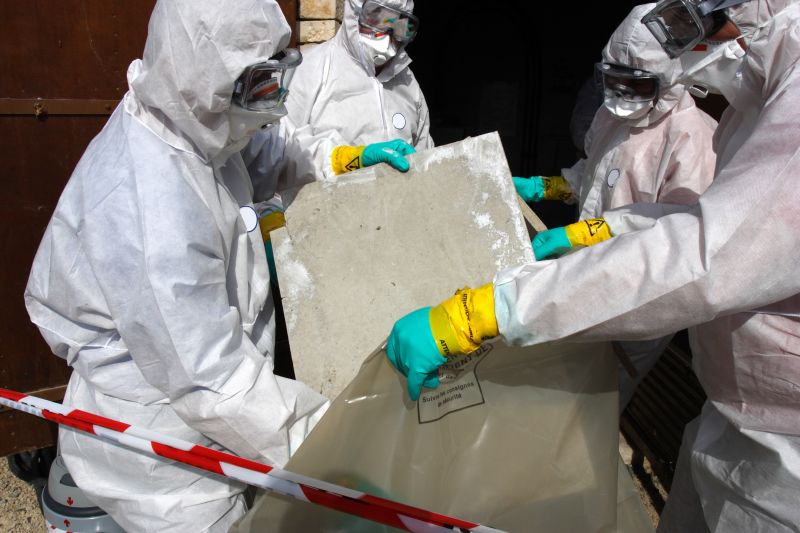Essential Products For Asbestos Abatement Professionals and Homeowners
Identify key supplies that ensure safety, compliance, and effectiveness during asbestos removal projects.
 Products for asbestos abatement are essential tools and materials used in the safe removal and containment of asbestos-containing materials. Proper selection of these products can help ensure that asbestos fibers are effectively contained, minimizing health risks during renovation or demolition projects. These products include specialized protective gear, containment barriers, disposal containers, and cleaning tools, all designed to meet safety standards and facilitate effective asbestos management.
Products for asbestos abatement are essential tools and materials used in the safe removal and containment of asbestos-containing materials. Proper selection of these products can help ensure that asbestos fibers are effectively contained, minimizing health risks during renovation or demolition projects. These products include specialized protective gear, containment barriers, disposal containers, and cleaning tools, all designed to meet safety standards and facilitate effective asbestos management.
Top Overall Option
Comprehensive Asbestos Abatement Kit
A complete asbestos abatement kit typically includes a range of protective gear, containment materials, disposal bags, and cleaning tools, providing a one-stop solution for asbestos removal projects. These kits are designed to meet safety standards and streamline the process, making them suitable for both professional contractors and experienced DIYers. They offer a balanced combination of safety, convenience, and compliance, helping users manage asbestos safely and effectively.
Types of Products For Asbestos Abatements
Respirators and Masks
High-efficiency particulate air (HEPA) respirators and masks designed to filter out asbestos fibers, providing essential respiratory protection during removal activities.
Protective Coveralls
Full-body disposable suits that prevent asbestos fibers from contacting skin and clothing, minimizing contamination risks.
Gloves and Hand Protection
Heavy-duty gloves resistant to asbestos fibers, ensuring safe handling of contaminated materials.
Eye and Face Shields
Protective eyewear and face shields to guard against asbestos dust and particles during removal and cleaning.
Plastic Containment Barriers
Heavy-duty plastic sheeting used to seal off work areas and prevent asbestos fiber spread.
Negative Air Pressure Systems
Ventilation systems that create negative pressure to contain asbestos fibers within the work zone.
Disposal Bags and Containers
Specialized leak-proof bags and containers for the safe disposal of asbestos waste.
HEPA Vacuum Cleaners
Vacuum cleaners equipped with HEPA filters designed to remove asbestos fibers from surfaces and equipment.
Wet Wiping Tools
Tools used for damp wiping surfaces to reduce airborne asbestos dust during cleanup.
Decontamination Showers
Portable showers used to decontaminate workers and equipment after asbestos removal tasks.
Sealing and Encapsulation Products
Materials used to seal or encapsulate asbestos-containing materials that cannot be removed immediately.
Warning Signage and Labels
Signs and labels indicating asbestos hazards and restricted access areas.
Air Monitoring Equipment
Devices used to measure airborne asbestos fiber concentrations during and after abatement.
Absorbent Mats and Wipes
Materials designed to absorb residual asbestos dust from surfaces and work areas.
Temporary Enclosures
Portable structures that contain asbestos work zones for added safety and containment.
Popular Choices
Widely used masks offering basic respiratory protection against asbestos fibers, suitable for low-risk tasks.
Lightweight, full-body suits designed for single-use to prevent contamination spread.
Portable vacuum units equipped with HEPA filters for effective asbestos fiber removal from surfaces.
Heavy-duty plastic films used to seal off work areas and contain asbestos fibers.
Protective gloves resistant to asbestos fibers, suitable for handling contaminated materials.
Ventilation units that create negative pressure environments to contain asbestos dust.
Damp cleaning cloths used to reduce airborne dust during cleanup procedures.
Clear signs indicating asbestos hazards and restricted areas for safety compliance.
Products used to seal asbestos-containing materials that cannot be removed immediately.
Portable setups for worker and equipment decontamination after abatement activities.
Equipment for measuring airborne asbestos levels to ensure safety standards are maintained.
Pads and mats designed to absorb residual asbestos dust on surfaces.
Portable enclosures that help contain asbestos work zones for added safety.
When undertaking asbestos abatement, it is crucial to use products that adhere to regulatory guidelines and provide reliable containment. Personal protective equipment such as respirators, suits, gloves, and eye protection are fundamental in safeguarding workers from asbestos exposure. Containment barriers, including plastic sheeting and negative air pressure systems, help isolate the work area and prevent asbestos fibers from dispersing into uncontaminated spaces.
Disposal solutions are equally important, with specialized bags and containers designed to securely hold asbestos waste for proper disposal according to local regulations. Cleaning and decontamination products, such as HEPA vacuums and wet wiping tools, assist in thorough cleaning of surfaces and equipment after removal activities. Selecting the right combination of these products is critical for a safe and compliant asbestos abatement process, ensuring that health risks are minimized and environmental safety is maintained.
Key Buying Considerations
- Ensure products meet local safety and regulatory standards for asbestos abatement.
- Select PPE with appropriate filtration efficiency for asbestos fibers, such as HEPA-rated masks.
- Opt for disposable protective gear when possible to reduce cross-contamination risks.
- Choose containment materials that are durable and resistant to tearing or puncture.
- Verify that disposal containers are compliant with hazardous waste regulations.
- Consider the size and scope of the project to determine the quantity and type of products needed.
- Look for products that facilitate easy and thorough cleaning to reduce residual contamination.
- Evaluate the compatibility of containment systems with existing work environments.
- Assess the availability of replacement parts and accessories for equipment like vacuums and ventilation units.
- Prioritize products with clear instructions and safety labels to ensure proper usage.
- Determine whether the products are suitable for professional or DIY use based on complexity.
- Check for compatibility with other safety and containment systems already in place.
- Consider the ease of storage and transportation of containment and protective materials.
- Review customer feedback and product ratings for insights into usability and reliability.
- Plan for proper training or guidance on the correct use of all asbestos abatement products.
